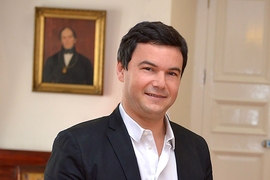Although Volha Charnysh initially distanced herself from her native land of Belarus, she has in recent years found reason to return to her Eastern European roots.
"In graduate school, I was at first reluctant to pursue questions that involved the region where I grew up — I feared it might be boring, or limit me somehow," says Charnysh, a newly-appointed assistant professor of political science. "But then I encountered compelling, quantitative political science on the legacy of violence on national identity and economic development, and I realized I could explore cases from Eastern Europe from fresh perspectives."
Charnysh's focus on the political and economic impacts of major historical conflicts began when she was a doctoral student in government at Harvard University. Pursuing a hunch, she investigated at a detailed, local level the massive population shifts that took place in and around Poland following World War II, a period when the redefinition of national boundaries displaced millions. This work involved a year in Poland, much of it in Warsaw archives, tracking the changing ethnic composition of more than 1,200 communities.
"It was fascinating to me," she says. "It involved an aspect of the war I hadn't known before, and that had a direct impact on the area where I'd grown up."
Charnysh also analyzed economic development before, during, and after the war in these municipalities — some where people had been forcibly resettled, and others where migrants moved voluntarily. She collected data on job creation and public service provision as well, through the end of Communist rule in Eastern Europe in 1989.
From her analysis, Charnysh learned that after what she calls the "churn of population," some communities contained homogeneous groups of migrants who had similar ethnic and cultural backgrounds, and other communities featured heterogeneous groups from disparate backgrounds.
"This distinction ultimately had a large impact," she says. "During the Communist period, homogeneous and heterogeneous communities were pretty similar, but after 1989, the heterogeneous communities had more enterprises and higher incomes."
Charnysh suggests that the difference in outcomes boils down to social dynamics: People in heterogeneous communities didn't get along as well as those in homogeneous communities, who banded together to provide services and goods for themselves. Heterogeneous communities, where people more likely distrusted their neighbors, demanded that the state provide more for them by way of health care, security, and education. In the long run, this facilitated the buildup of state capacity and promoted private economic activity that eventually benefited the entire municipality.
"Heterogeneity really paid off after Communism," Charnysh says.
The vast trove of data Charnysh collected is the basis for an ongoing book project she has titled "Migration, Diversity and Economic Development." It has also inspired several related research articles, including the provocatively titled "The Death Camp Eldorado: Political and Economic Effects of Mass Violence," published in the American Political Science Review.
In this study, conducted in collaboration with Evgeny Finkel, Charnysh revealed previously undocumented local impacts of the Holocaust.
"I was curious about what happened in the areas where Jews disappeared, and where the ethnic composition changed drastically," she says. Charnysh learned that the assets of Jews murdered in the Nazi death camp, Treblinka, sometimes benefited the population of the surrounding communities.
Charnysh also discovered that areas where there were more Jews before World War II not only registered higher support for anti-Semitic parties, but also voted against joining the European Union in the 2003 accession referendum. She argues that legacies of interethnic competition made voters in these localities more susceptible to arguments that linked membership in the European Union to Jewish influence.
As a result of her research, Charnysh has come to see a part of the world she thought she knew in an entirely different light. She was born in Grodno, a town on Belarus’s western border that over the centuries was a part of the Duchy of Lithuania, the Russian Empire, and Poland. While the historic old town contains a building once used as a synagogue, Charnysh says she "had only a vague sense that there was a Jewish population before."
The patriotism of her countrymen, not the Holocaust, "was central to our nation's World War II experience," she says.
Her father and mother, both lawyers, were intent on her getting the best education possible, and realized that might mean leaving Grodno. When the chance came to participate in a student exchange program in the U.S., the 15-year-old Charnysh seized it with her parents’ blessing.
"The United States was the land of freedom and opportunity, and they wanted this for me," she says.
The Future Leaders Exchange program, sponsored by the U.S. State Department for high school students of former Soviet republics, proved foundational for Charnysh. "I appreciated how different the U.S. was from Belarus, in terms of both wealth and politics," she says. "I no longer wanted to return to Belarus, and decided to apply to colleges in the U.S."
With the help of scholarships, she first attended Cottey, a two-year women's college in Missouri, then Smith College, where she received a BA in government. After college she took a one-year fellowship researching non-proliferation at the Arms Control Association in Washington, before launching on her current academic journey.
Today, Charnysh ponders extending her research to regions outside of Eastern Europe. "I would like to see if my hypothesis about heterogeneous communities, state capacity, and economic outcomes holds in other contexts — maybe Israel, or India after partition," she says.
Charnysh believes her historical research bears on contemporary issues and says she is learning how immigrants integrate into new communities, and how diverse populations facilitate the creation of strong national identities. These matters have personal resonance for her.
"I have been an immigrant myself and after living for years abroad, understand the problems of making a new home," she says, although it's good to feel settled. "I have a sense of solidarity with my political science colleagues here, and it is really good to be part of the broader academic community."










